 |
Site created 12/15/97.

page created: 4/6/00
Stuart Little DVD Event
Sony Pictures Studios - Culver City, CA - 4/5/00
  On the left: Stuart Little director Rob Minkoff and Bits editor Bill Hunt. On the right: The finished DVD (widescreen version, of course). |
| Yesterday
morning, I had the good fortune to attend a special press event at
the Sony Pictures DVD Center, in honor of the release of Columbia
TriStar's forthcoming Stuart Little:
Collector's Series DVD. The event was sponsored by
Columbia TriStar Home Video, and featured a special appearance by
the film's director, Rob Minkoff. The usual suspects were all in
attendance, including our friends Peter Bracke (from
DVD File),
Guido Henkel (from DVD
Review) and Michael Coate (from
Widescreen
Review). The Sony DVD Center is located on the Sony Pictures studio lot, in the heart of Culver City, CA. I pulled onto the lot at about 9:30 AM, and met up with everyone for introductions and general catching up with my fellow website editors. Kicking off the day was a special behind-the-scenes tour of the DVD Center, led by Leslie Haas (the Center's VP and General Manager). So after a quick stop for coffee, we walked across the lot to the famed Capra building, which houses not only the studio's DVD operations, but also the Sony Pictures High Definition Center. I think Frank Capra would be proud to have his name attached to such a wonderful place. The pictures you're about to see aren't of the greatest quality (dark rooms just don't photograph well) and they depict only a very small fraction of the whole Center. But they should give you a sense of what the place is like. So let's take a look around... |
 The Sony DVD Center's main equipment room. |
| The tour itself
began in the lobby, and then led to a brand new, state-of-the art
DVD screening room. The room is functions as the perfect audio and
video viewing environment, and was designed with the help of
Tomlinson Holman (he's the "TH" in THX). From there, we
were led through the main equipment room, which services both the
DVD and High-Def Centers. It's stacked floor to ceiling with racks
full of monitors and video and audio decks in various formats -
Digi-Beta, D1 and the like. We learned that the center is generally
working on well over 60 DVD projects at any given time, including
multiple language versions of many titles for release in Europe,
Japan and elsewhere overseas. The center runs two shifts to keep all
the work on track, with only a few hours of late-night down time for
equipment maintenance. |
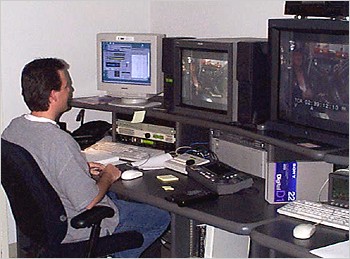 An MPEG-2 video compression station. |
| As we moved into
the video compression area, we were astonished to learn that the
video on the Stuart Little DVD
was MPEG-2 compressed at an average bit rate of just 3.75 mpbs!
That's astonishing, given the high quality of the final product. As
a general rule, the greater the bit rate during compression, the
better looking the video. But the reason that such low bit rates can
be achieved at Sony, has to do with the quality and efficiency of
their video process. First of all, 95% of the DVD projects done at
Sony are originated in high definition, from fully-digital transfers
done right at the HD Center. Next, the Sony MPEG-2 encoding hardware
and software is proprietary. I happen to think that it's the best
system in the business (and I think my fellow webmasters would
agree). It's an extremely efficient system. The video is run through
the encoder multiple times. After each pass, a highly trained
technician looks at the result for quality. Whenever problem areas
are found (such as visible artifacting), the software is adjusted
and another pass is run to perfect the picture quality. On average,
4 or 5 passes will be done for each film. For films involving highly
complex action, additional passes may be done (Stuart
Little took 8 passes). You may be interested to know that while we were there, the video compression for the studio's upcoming Men in Black DVD was being finalized. |
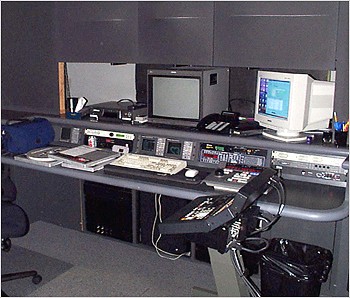 A multi-channel audio compression bay. |
| Next up was the
audio compression station. Each room is again a perfect listening
environment, designed with the specific needs of 5.1 and 6.1 audio
in mind. You may be surprised to learn that the surround sound mix
you hear at home, and what you heard in the theater, is completely
different. The reason for this, is that the audio environments are
different. When you're sitting in a large movie theater full of
popcorn-crunching people, you're just not going to hear small flaws
in a 5.1 soundtrack, like sloppy dialogue edits or pops and hisses
in each channel. But at home, you're sitting much closer to each
speaker, so you will hear every flaw. To meet the special needs of
home theater, a separate surround sound mix is almost always done
(always at Sony) to make sure that the audio sounds as good in your
living room as possible. The audio compression rooms at the Sony DVD Center take all of the multiple digital channels of audio (the Dolby Digital 5.1 mix, the foreign language tracks, the director's commentary, etc...) and compress that data so that it will fit on a DVD disc, while still retaining the highest quality possible. You'll be happy to know that these rooms can handle DTS 5.1 audio as well, and will soon be doing so for at least two upcoming Columbia TriStar DVDs (including Men in Black). |
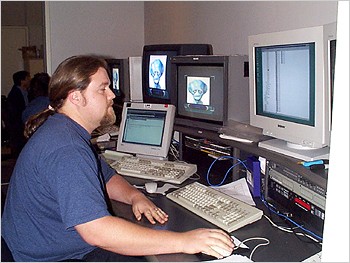 DVD menu design for Men in Black in progress. |
| Of course, no DVD
would work without menu screens to help you navigate the disc's
contents. Above, you can see a technician designing and planning the
interactivity of the DVD menu pages for Men
in Black. This is extremely intricate work - each button
press must be programmed into the system, and sometimes many tens of
thousands of separate graphic elements are involved to create the
menus for a single DVD. Add to that the fact that each page must
then be translated into multiple languages, and you can see what a
complicated process this becomes. |
 The DVD programming lab - this is where it all comes together. |
| When all of the
individual elements for a given DVD are complete, they're sent to
the DVD programming lab. This is where every piece of a DVD is
assembled into the disc's final form. All of the complex authoring
needed to make the disc work is completed here (again on
custom-designed software), and a final disc "image" is
burned onto check discs, which are then vigorously tested in house. One thing to note here, is that the Sony DVD Center has designed an elaborate computer database system to keep track of the progress on every disc being developed in house. With so many titles being worked on at one time, everyone involved in the process must have access to information on the status (and location) of each needed element, from the video transfer to each individual menu graphic. |
 One of several DVD Quality Control stations. That's the Japanese version of Heavy Metal under inspection. |
| Once a title
reaches the QC stage (Quality Control), every possible function
designed into the disc is checked, again using specially designed
software and hardware. The audio and video are checked for quality,
and every button press in the menus is checked to make sure that the
right result occurs. If there's an error, the programming must then
be corrected and a new check disc burned. Often, several revisions
are required before everything works properly in testing. When the disc finally meets with QC approval, the programming lab creates a final DLT (digital linear tape) master, which includes every element of the final DVD (including all programming). This is then sent to a separate DVD replication facility, which creates a set of its own check discs. These are sent back to the DVD Center (and to outside quality assurance vendors) for vigorous testing in every make and model of DVD player possible (more than 100 individual models). If an error is found, it's back to programming again. But if the DVD passes every possible test, final approval is given and the replicator receives the go-ahead to start manufacturing hundreds of thousands of copies of the finished DVD for shipment to distributors, and on to your local video store. And that's the Sony DVD process in a nutshell. Cool, no? But as I mentioned earlier, this day was all about Stuart Little - Columbia TriStar's most ambitious and complex DVD release yet (although Men in Black will definitely top it). So after the DVD Center tour, it was off to a special screening room (in a nearby building on the Sony lot), where many members of the DVD Center staff (involved in the creation of the actual disc) were gathered to answer questions, along with the film's director, Rob Minkoff. |
 Stuart Little director Rob Minkoff talks DVD. |
| Stuart
Little marks Rob's second time as a feature film director
(he first co-directed The Lion King
and worked on several other animated projects at Disney). It's also
his first solo and live-action effort. After being introduced to the
press by Columbia TriStar's VP of Worldwide Publicity, Fritz
Friedman, Rob stood up and addressed the crowd about DVD. He was
like a kid in a candy store. "If I seem a bit excited, it's
because I am!" he said. "This is the first time I've seen
the final DVD myself." A large video projection screen was set-up in the front of the theater, and we previewed the DVD in style, as Rob and the DVD staff talked about the creation of each element and feature. The experience gave the term "live commentary" new meaning - we actually had the film's director with us in person, and we were even able to ask him questions as we went! |
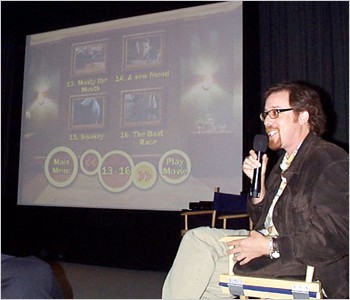 Can you tell Rob's excited? This is the first time he's seen the final DVD. |
| "I think the
thing that's so great about special editions like this on DVD and
laserdisc, is that lots of young directors use them almost like film
school classes," Minkoff says. "I'm not sure that everyone
would go through all of this content, but for many, it's a great way
to get an insight into the work process of experienced directors." Minkoff considers this kind of personal involvement in DVD (with working on the DVD version of a film you direct) to be an important part of the process of making a film. His experience is that most other directors and creative individuals in the business share that sentiment with him. Consumers too are getting more involved. "Everything is changing right now, in terms of the technology," he noted. "More people are getting interested in this kind of behind-the-scenes material because of DVD." |
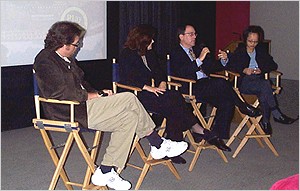 The Q&A session about the DVD. |
| In the question
and answer session that followed the presentation, we learned a
number of interesting things. First of all, the gathering of
materials for use in the DVD began in the earliest stages of the
making of Stuart Little, but
the actual DVD production time was only three weeks. As many of you
may know, dual widescreen and full frame versions of the film (with
identical special edition content) are being produced to test
consumer reaction to each format. Fear not - Columbia TriStar will
never stop releasing its DVDs in anamorphic widescreen. But they
recognize that many consumers still don't appreciate the difference,
and they're making an effort to please everyone by doing two
versions, when they can't include both on the same disc. And while
the studio doesn't have a lot of data on just how much their DVDs
are used in computer DVD-ROM drives, this disc marks the third time
they've added ROM content to a title (Ghostbusters
and The Thirteenth Floor also
featured computer-based features), something they expect to do more
of in the future. After the formal Q&A session, we all spent about an hour chatting informally, and asking Rob and the staff individual questions about the making of the film and the DVD. Everyone was extremely friendly and willing to talk at length with us on a variety of subjects. As they used to say in the social column of the small town newspaper back home, "A good time was had by all." |
 L to R: Leslie Haas (VP & General Manager of the Sony Pictures DVD Center), Fritz Friedman (VP of Worldwide Publicity for Columbia TriStar/Sony Pictures), Stuart Little director Rob Minkoff, Don Levy (Executive Director of Marketing and Communications for Sony Digital Studios), Scott Hettrick (Editor-in-Chief of Video Business magazine) and Yuen Chung (Manager of DVD Marketing for Columbia TriStar Home Video) |
| The
Digital Bits would like to thank to Rob Minkoff, Fritz
Friedman, Leslie Haas, Jeff Kaplan and everyone at the Sony DVD
Center, Columbia TriStar Home Video and Jane Ayer Public Relations
for their generosity and for putting on a great event. We hope you enjoyed our look behind-the-scenes as much as we did. Thanks for reading! As always, I welcome your comments. Bill Hunt, Editor The Digital Bits billhunt@thedigitalbits.com |

| Site
designed for 800 x 600 resolution, using 16M colors and .gif 89a
animation. © 1997-2015 The Digital Bits, Inc., All Rights Reserved. billhunt@thedigitalbits.com |